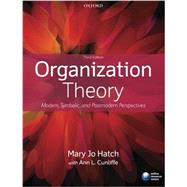Organization Theory Modern, Symbolic, and Postmodern Perspectives

Organization Theory Modern, Symbolic, and Postmodern Perspectives
- ISBN 13:
9780199640379
- ISBN 10:
0199640378
- Edition: 3rd
- Format: Paperback
- Copyright: 04/05/2013
- Publisher: Oxford University Press
- Newer Edition
Used From $60.28
Sorry, this item is currently unavailable.
List Price $82.08 Save $21.80
Used
$60.28
Usually Ships in 24-48 Hours
We Buy This Book Back!
Included with your book
Free Shipping On Every Order



